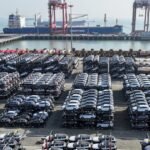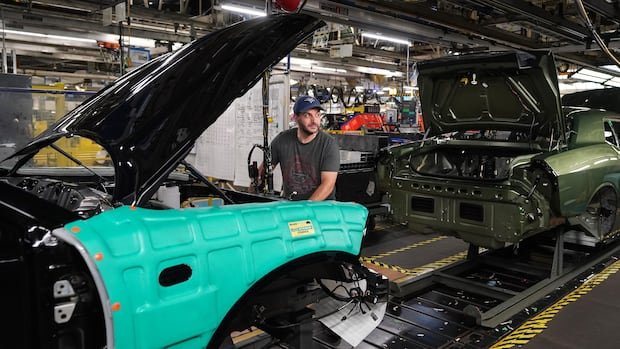While recent headlines have focused on Donald Trump’s threatened tariffs against Canadian goods, Canadian retailers have also been considering the potential impact of additional fees They threaten him with products from China.
This could affect Canadian brands that make products overseas and sell them south of the border. That includes Groupe Dynamite, Aritzia, Lululemon and Canadian Tire, all of which have been asked about tariff threats during their latest earnings calls.
“Knowing that there will be a transition in the first quarter of the year, we have already taken steps – I won’t go into the percentage – but we have already taken steps to move more production out of China,” Andrew Lutfy, CEO of Groupe Dynamite, said in a recent Call with investors.
Groupe Dynamite, a Montreal-based clothing company, has been expanding in the United States since 2007 and has 109 Garage stores and five Dynamite stores south of the border, according to its latest report. investor presentation.
The trend of companies moving their production out of China is not new. Tensions between the United States and China have been rising for years, and rates that began during the first Trump administration were maintained under his successor Joe Biden.
This has led companies to make plans. moveand that has only been accelerating recently. the shoemaker Steve MaddenFor example, it said it plans to reduce its Chinese-made products by 40 percent, down from a previous target of 10 percent.
And just as the Canadian government has matched U.S.-China trade restrictions with its own tariffs on electric vehicles, Chinese steel and aluminum, rising geopolitical tensions have led Canadian companies to examine their trade relationships with China.
“The Canadian business community is seeing those signs and realizing that there are potential vulnerabilities in having a significant part of their supply chain located in China,” said trade lawyer John Boscariol, partner at the firm McCarthy Tétrault.
Some Canadian brands say they are moving production out of China, a move sparked by geopolitical tensions, tariff threats and concerns about forced labor.
Forced labor is another factor
The threat of tariffs aside, the move away from China has also been driven by concerns around forced labor. There is growing evidence of human rights abuses against ethnic Uyghurs in China’s Xinjiang region, a hub for cotton and other goods production.
With the passage of the U.S. Uyghur Forced Labor Protection Act, businesses now risk holding certain assets arrested at the border and force them to prove that they are not made with forced labor.
“There has been the normal issue of forced labor and then the fighting between the United States and China,” said Carlo Dade, trade director at the Calgary-based Canada West Foundation. “That’s why companies are suddenly taking more extreme or extraordinary measures.”
Costs may also have played some role in the change, said Bob Kirke, executive director of the Canadian Apparel Federation. As China developed economically, “labor costs have increased,” he said. “That’s very simple.”
Greg Hicks, president and CEO of Canadian Tire, which also owns the international Helly Hansen brand, told investors This year alone has seen a “considerable shift” in source country sourcing outside of China.
“In regards to any type of commercial escalation between [the] United States and China and how that affects us just from that point of view, we are in a less situation [risky] position than we would have been in last year at this point,” Hicks said in the fall.

Aritzia, a Vancouver-based retailer that growing rapidly in the U.S., said this month that it has been working to “systematically diversify” its manufacturing since the company went public in 2016.
“What I can say now is that the vast majority of our products are made outside of China,” CEO Jennifer Wong said, in response to an analyst question about the tariffs.
Lululemon, another Vancouver brand, has also told investors it has “very limited exposure” in China.
“We outsource about three percent of products from China, so the exposure there is relatively small,” the company’s chief financial officer, Meghan Frank, said during its latest conference call. earnings call.
Untangling the supply chain
It may be difficult for companies to fully disentangle their supply chains from China, given how dominant the country is as a supplier.
Kirke, of the Canadian Apparel Federation, said the country is also extremely capable of manufacturing not just textiles but all the small, complicated parts needed to make a garment, from zippers to linings and backings.
“There are others [manufacturing] options, but making sure you can do everything you want is a challenge,” Kirke said.
Calgary jewelry designer Melissa Victor, who uses materials including wholesale beads, cabochons and rhinestones bandsagreed.
“If I were trying to [fully] “If I bought things that weren’t made in China, these shelves would be empty,” Victor said, pointing to a wall of supplies inside the downtown office of his indigenous jewelry brand Kwósel.
To further complicate matters, Dade of the Canada West Foundation said many Chinese manufacturers have invested in supply chains throughout Southeast Asia. That means moving production to another country might not solve the problem.
“Even if you try to flee China, you’ll just run into China,” Dade said.
As tensions between North America and China continue, Dade said he will be watching to see if Canada provides any assistance to companies trying to leave the country. The government of Japan, for example, has even gone so far as to pay companies moving production from China back to Japan or Southeast Asia.
“That may not be exactly what we need to do,” he said. “But I think we have to be much more creative to help companies that need to leave make the change.”









